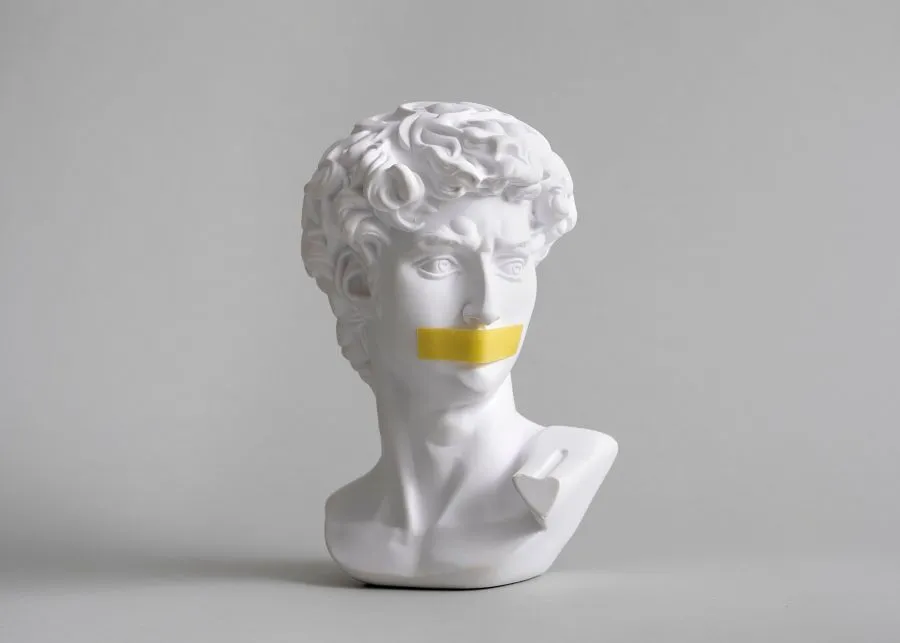In free democracies like Australia and Great Britain, we assume artists can express what they want in their work without fear of persecution.
Unlike in some countries where they could be imprisoned for art that challenges political or moral standards, democracies are usually far more supportive of artists’ free speech.
Though in recent years, some artists have detected complex new pressures that are threatening to curtail what they feel they can say in their work.
ArtsHub spoke to one established artist who described how ‘it feels like you have to be more careful now,’ when dealing with morally challenging subjects, and that they ‘would think twice about doing that kind of [extreme] work now.’
Widespread moves towards artistic cautiousness?
This feeling of having to ‘think twice’ before presenting risky ideas in art is a trend seen both at home and overseas.
At this year’s Documenta art exhibition in Germany, for example, a work by one of its invited artist-collaboratives had to be covered up after public accusations that it included an anti-Semitic reference. The large outdoor banner work entitled People’s Justice by Indonesian art group Taring Padi included a cartoon-like figure many interpreted as a derogatory portrayal of a Jewish person.
In defending the work, the creators explained that the piece (which interestingly, was first exhibited at the Art Gallery of South Australia in 2002 without issue) was intended to depict ‘part of a campaign against militarism and the violence [they] experienced during Suharto’s 32-year military dictatorship’, and that it was in no way related to antisemitism.
Yet public outrage persisted to the point that less than a month after the furore, Documenta’s Director Sabine Schormann resigned over the issue.
In this case, it seems understandable that the German public felt particularly sensitive about links to antisemitism in their publicly funded art, but the consequences for the festival’s Director appear unprecedented.
For well-known poster Australian artist Peter Drew, this high profile controversy reveals some concerning new trends towards binary interpretations of art.
Read: Making great propaganda art
‘What I see in that Documenta example is a pulling towards singular interpretations of art, rather than being tolerant of multiple interpretations,’ he told ArtsHub.
‘I see it as a pull towards understanding art in terms of “it means this” or “it means that“, so artists and curators get pulled into having to define the artwork in those terms. And I think you’ve already lost when you’re drawn into having to define your art within that limited frame,’ he said.
Where’s the middle ground?
For internationally celebrated artist Julie Rrap – a practitioner who has been at forefront of feminist art in Australia since the mid 70s – there are many dangers inherent in binary interpretations of art, especially when pushed to political extremes.
‘It doesn’t matter whether your view [of the art] comes from a far right or far left position – both are dangerous because they lack any sense of a middle ground on which to explore ideas,’ she observed.
‘Art is about allowing people not to have limits on their imaginations,’ she continued. ‘So if audiences are starting to look for something political in the work that may or may not be there, and then they are interpreting it in those narrow terms, that’s a dangerous direction for art to be heading. It’s reducing art to propaganda!’
Similarly, Catalan-born artist Dani Marti – who is currently based in Sydney and whose past works have explored explicit ideas around sexuality – said that recent trends towards dogmatic political thinking are encroaching on artist and audience freedoms.
‘Art is a platform where you should be allowed to question certain power structures,’ Marti told ArtsHub. ‘But the current climate [of political dogma] is absolutely compromising that work and jeopardising creativity.’
Defending spaces for uncomfortable ideas
In response to what has, in recent years, felt like somewhat of a closing-in on artists who question power structures and orthodoxies, the Sydney-based Festival of Dangerous Ideas (established in 2009) has become a sacred space for artists to speak about their work without fear of suppression.
This year’s festival included artist-speakers like Claire G. Coleman and Baduicao. Its director Dr Simon Longstaff said these forums remain vital ways for the public to engage with artists’ difficult ideas.
‘Art plays an essential role in holding up a very well-polished mirror on society, which inevitably has the capacity of making us uncomfortable, because it presents a view of us that most of us don’t want to know about,’ he told ArtsHub.
‘So we need to preserve those spaces where it’s Ok [for artists] to push at the boundaries of what’s accepted – especially at the moment, where there’s a tendency to shut things down.
‘We need artists to keep pushing at those boundaries to help preserve that middle space [for discussion and debate].’
Read: Artist censored from Hong Kong protest exhibition
Longstaff has also observed how artists with contentious ideas are increasingly being caught up in dialogues that unfairly assign them with particular moral labels.
He commented that, ‘It used to be when people disagreed with your ideas they’d say “I don’t agree with your ideas or your perspective” and you’d start to explore that. But it’s now become, “I don’t agree with your ideas and that means you are a bad person”.’
For Rrap, the effects of these narrow judgements on the next generations of artists is especially concerning. ‘It does worry me to think that young artists might feel too scared to say anything in their work for fear of being shut down,’ she said.
‘Risk is crucial as an artist, and it’s important to allow artists to step outside those boundaries of convention so they can explore ideas that are occurring to them in their imagination, and we should acknowledge that those ideas are not necessarily connected to real life or reality,’ Rrap concluded.





